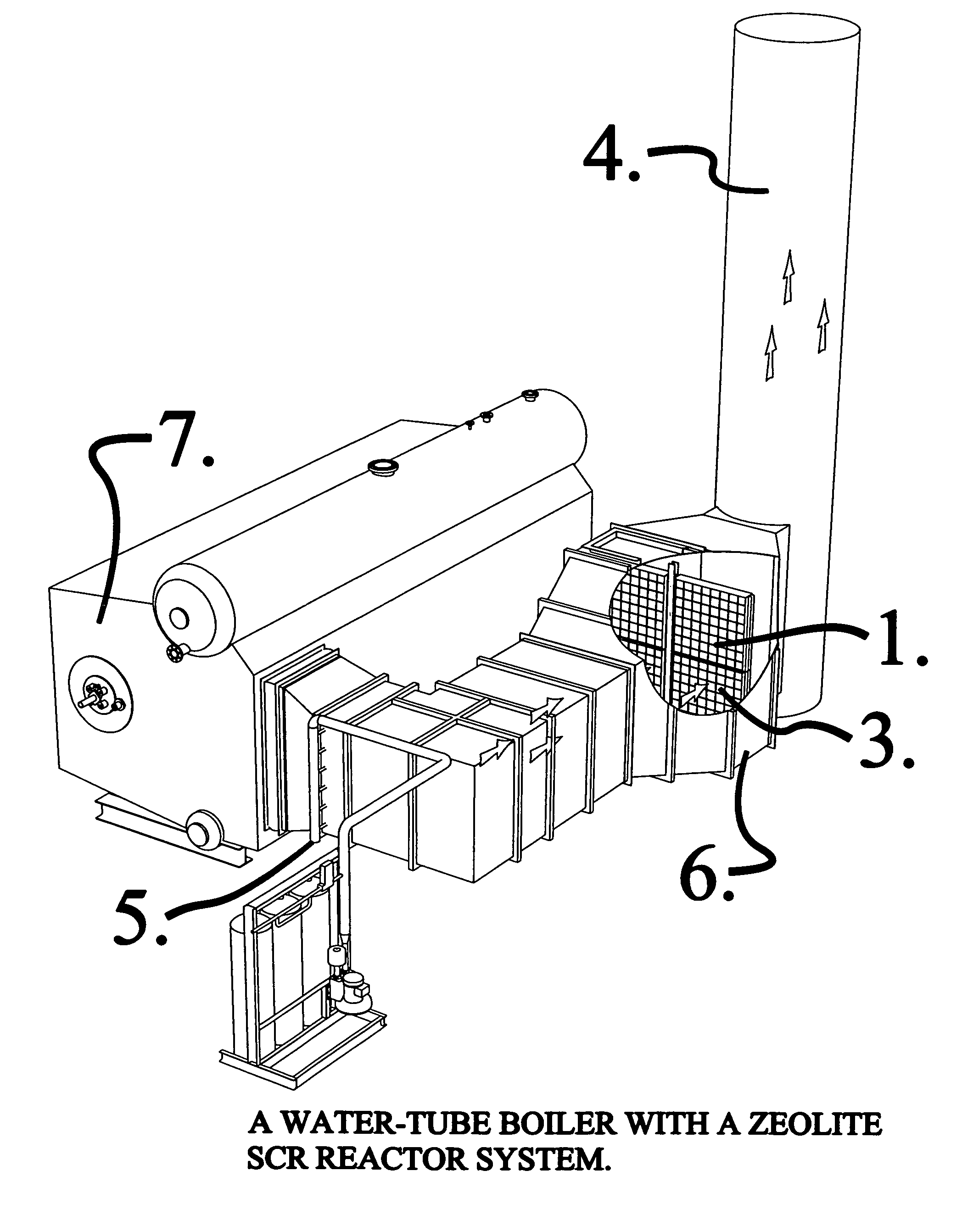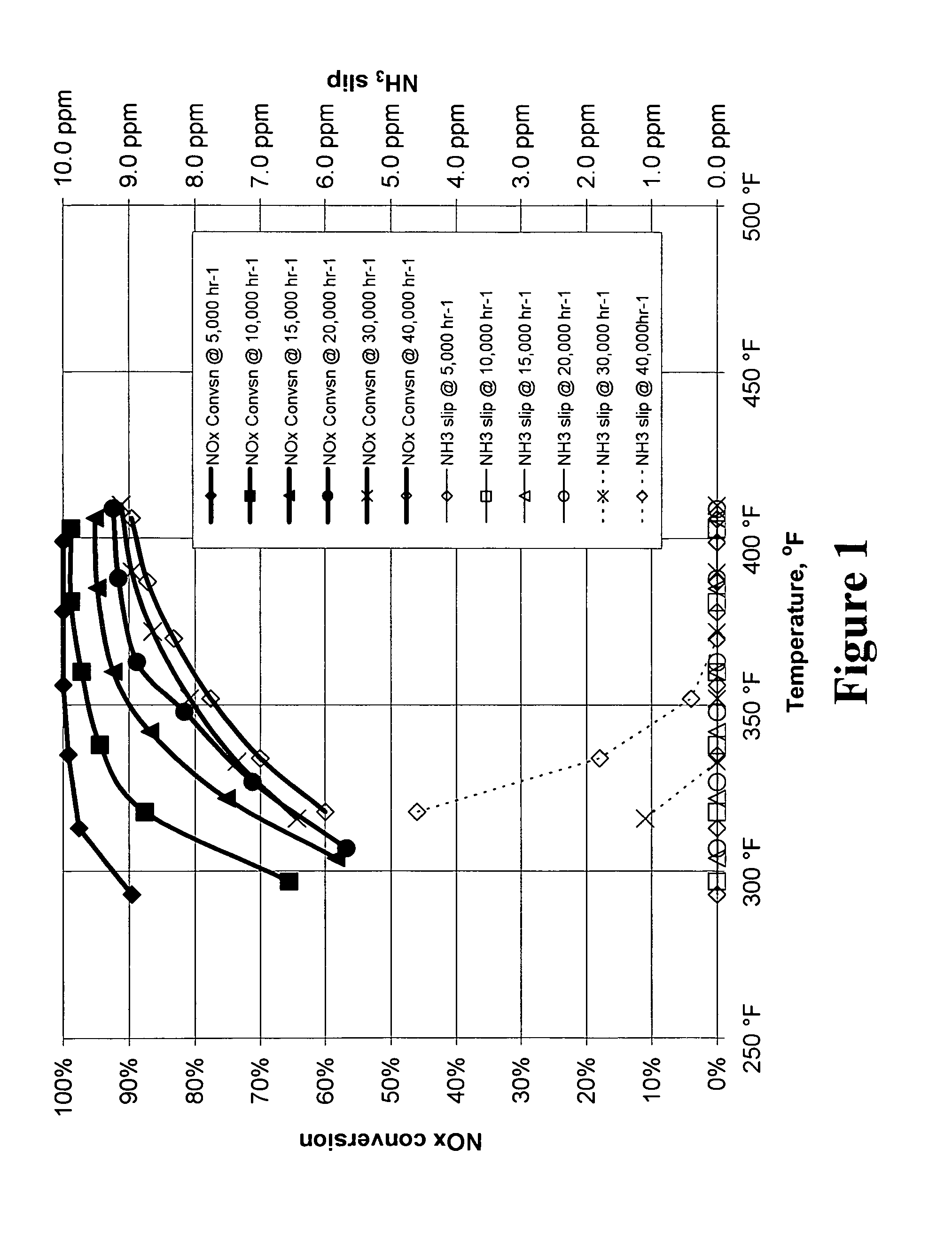Reactor system for reducing NOx emissions from boilers
a reactor system and boiler technology, applied in lighting and heating apparatus, physical/chemical process catalysts, separation processes, etc., can solve the problems of increasing energy costs, significant polluting emissions, and burners used with such boilers, and achieve the effect of more reliable and energy efficien
- Summary
- Abstract
- Description
- Claims
- Application Information
AI Technical Summary
Benefits of technology
Problems solved by technology
Method used
Image
Examples
example 1
NOx Conversion and NH3 Slip at Various Space Velocities
[0083]A slurry was made comprising of 50% HZSM-5 zeolite and 50% oxygen storage material with water. This formed the washcoat. This washcoat was coated on a 210 cpsi ceramic honeycomb substrate to achieve a loading of 200 grams per liter of the washcoat on the ceramic honeycomb 210 cpsi substrate. The channels of the wet washcoated substrate were cleared by blowing air using an air knife. The washcoated substrate was fired at 550° C. for 4 hours to get a calcined washcoated substrate. A solution mixture of cerium nitrate, manganese nitrate and copper nitrate was made and impregnated on to the washcoated honeycomb substrate. The solution of cerium nitrate, manganese nitrate and copper nitrate was made such that it will result in a cerium loading of 20 grams per liter, manganese loading of 12.5 grams per liter and copper loading of 5.25 grams per liter on the final impregnated honeycomb catalyst. This catalyst was tested at boiler...
example 2
NOx Conversion and NH3 Slip at Various Temperatures and Space Velocities on Sulfur Aged Catalyst
[0088]Boiler exhaust may contain sulfur compounds primarily as SO2. The amount of SO2 in a boiler exhaust depends on the type of fuel being burnt in the boiler. Pipeline natural gas is a common fuel for industrial and commercial boilers. Natural gas suppliers such as PG&E provide information of the amount of sulfur present in natural gas. In the years or 2006 and 2007, PG&E provided pipeline natural gas that had total maximum sulfur anywhere from 3 ppm to 15 ppm. Cleaver Brooks, a manufacturer of industrial and commercial boilers, published emissions reference guide that mentions that such a sulfur containing natural gas when burnt in industrial and commercial boilers will result in a SO2 concentration of about 0.34 ppm in the boiler exhaust. Tests were performed using the catalyst described in example 1 and subjecting the catalyst to a sulfur aging using a stream comprising of 1 ppm of S...
PUM
| Property | Measurement | Unit |
|---|---|---|
| weight % | aaaaa | aaaaa |
| molar ratio | aaaaa | aaaaa |
| molar ratio | aaaaa | aaaaa |
Abstract
Description
Claims
Application Information
 Login to View More
Login to View More - R&D
- Intellectual Property
- Life Sciences
- Materials
- Tech Scout
- Unparalleled Data Quality
- Higher Quality Content
- 60% Fewer Hallucinations
Browse by: Latest US Patents, China's latest patents, Technical Efficacy Thesaurus, Application Domain, Technology Topic, Popular Technical Reports.
© 2025 PatSnap. All rights reserved.Legal|Privacy policy|Modern Slavery Act Transparency Statement|Sitemap|About US| Contact US: help@patsnap.com



